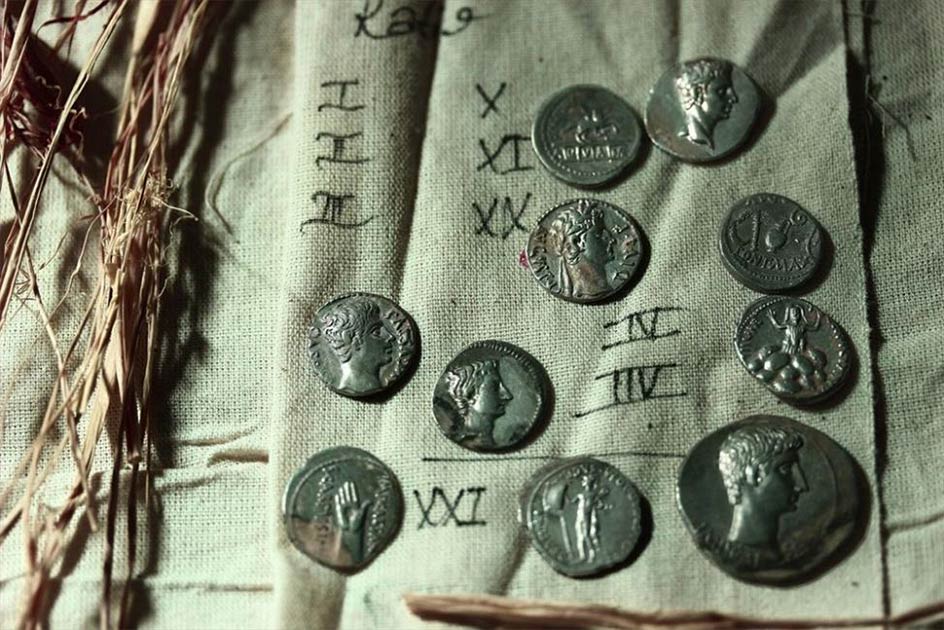Jug of Priceless Ancient Roman Coins Discovered in Special Turkish City
A “very special and unique collection” of ancient Roman coins have been unearthed at an equally special 5,000-year-old archaeological site in Turkey. More than 650 priceless coins were found at Aizanoi, which is located in the Kutahya province and has been compared to the famous ancient city of Ephesus.
A Jug of Rare Ancient Roman Coins
“These 651 silver coins, from the era of Emperor Augustus, constitute a very special and unique collection,” Elif Özer, a professor at Pamukkale University and the archaeologist in charge of the dig at Aizanoi, told Anadolu Agency.

One of the ancient Roman coins discovered in the ancient city of Aizanoi, Kütahya province, Turkey. (Andalou Agency)
The ancient coin collection is comprised of 439 Roman silver denarius coins and 212 cistophorus coins which come from the ancient Greek city of Pergamon. The archaeological team believes that the coins may have belonged to a high-ranking soldier. “These silver coins are a ‘coin album’ of the last century of the Roman Republic period. It constitutes a very special and unique collection,” Özer said. The professor has also called this discovery “the most outstanding silver coin collection found in recent times.

Precious Roman coins that were discovered in the ancient city of Aizanoi, Kütahya province, western Turkey. (Hürriyet Daily News)
Özer said the ancient Roman coins were found in a jug that was protected by terracotta plates. It was discovered and carefully unearthed in a waterway which runs through the 5,000-year-old site. The excavators found the jug while working on a riverboat project. According to Daily Sabah, the goal of the project is to provide visitors with the chance to explore the site’s ruins on sailboats which will pass through the waterways “just as the Romans did centuries ago.”

The ancient Roman coins were found in a jug that was protected by terracotta plates. (Aizanoi Excavation Directorate /Anadolu Agency)
Aizanoi, A Special Archaeological City
The ancient city of Aizanoi is located 57 kilometers (35 miles) from the Kütahya city center in western Turkey. It is fondly referred to as “the second Ephesus of Turkey” and was added to the UNESCO World Heritage Tentative List in 2012.
- Making Money Divine: Roman Imperial Coins had a Unique Value in Scandinavian Cultures
- Hoard of Roman Coins Leads to the Discovery of Important Site in England
- Theatre of Treasure: Roman Gold Coins Found in Northern Italy ‘Could Be Worth Millions’
A Turkish archaeological team led by Pamukkale University’s Archaeology Department has been working at the site since 2011 and they began restoration work there in June 2020 following the years of damage by landslides and earthquakes. Before then, archaeologists from the German Archaeological Institute worked at the site from 1970 to 2011.
The most famous feature at the site is the Temple of Zeus, which is said to be the best-preserved temple honoring the Greek god in all of ancient Anatolia. It also houses the ruins of an impressive ancient theater and stadium, a gymnasium, five bridges, a trade building, cemeteries, two public baths, and a sacred cave called Metre Steune, which was used before the first century BC.

The most famous feature at the Aizanoi archaeological site is the Temple of Zeus - the best-preserved temple honoring the Greek god in all of ancient Anatolia. (ErdalIslak /Adobe Stock)
The excavations at the Temple of Zeus suggest that there has been a settlement at the site since 3000 BC. The Roman Empire captured the city in 133 BC and the Turkish Culture and Tourism Ministry's website says that the city “experienced its golden age in the second and third centuries AD and became the center of the episcopacy in the Byzantine era.” The site was rediscovered in 1824 by European travelers.
The coins are now exhibited in the Museum of Anatolian Civilizations in Ankara. Özer told Anadolu Agency that the archaeological team is currently preparing journal articles and books in Turkish and English to promote the discovery of the rare and priceless ancient Roman coins.

The ancient Roman coins are now exhibited in the Museum of Anatolian Civilizations in Ankara. (Andalou Agency)
Top Image: More than 650 priceless ancient Roman coins have been unearthed at the Aizanoi archaeological site in Turkey. Source: Andalou Agency



















